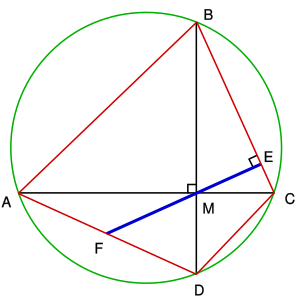Timeless Theorems of Mathematics/Brahmagupta Theorem
The Brahmagupta's theorem states that if a cyclic quadrilateral is orthodiagonal (that is, has perpendicular diagonals), then the perpendicular to a side from the point of intersection of the diagonals always bisects the opposite side.[1]
The theorem is named after the Indian mathematician Brahmagupta (598-668).
Proof
Statement
If any cyclic quadrilateral has perpendicular diagonals, then the perpendicular to a side from the point of intersection of the diagonals always bisects the opposite side.
Proof

Proposition: Let is a quadrilateral inscribed in a circle with perpendicular diagonals and intersecting at point . is a perpendicular on the side from the point and extended intersects the opposite side at point . It is to be proved that .
Proof: [As both are inscribed angles that intercept the same arc of a circle]
Or,
Here, °
Or, °
Again, °
Or, ° [As ° and ]
Or, ° °
Or,
Or, [As, \angle AMF = \angle CME; Vertical Angles]
Therefore,
In the similar way, and
Or, [Proved]
Reference
Template:Reflist Template:BookCat
- ↑ Michael John Bradley (2006). The Birth of Mathematics: Ancient Times to 1300. Publisher Infobase Publishing. ISBN 0816054231. Page 70, 85.